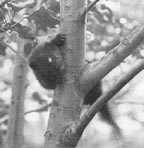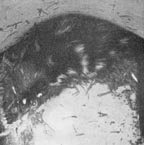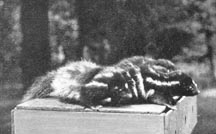THE POLECAT
page 75 It was a bleak day in midwinter when the Naturalist started out for his usual walk.
The sky was overcast and a light snow covered the ground--just the kind of day when one enjoys a book and a snug seat by the fire. As he entered the bit of woods near his home a flock of tree sparrows and juncos flew out of the underbrush and alighted in the trees. A chickadee eyed him suspiciously, as if in doubt as to his identity. The residents of the wood had come to feel safe with him and seldom manifested any particular anxiety because of his presence.After looking about for a time for something of special interest, he chanced upon the tracks of a little spotted skunk (spilogale interrupta), commonly known by the name “polecat.” Since the snow was fresh, the tracks offered an opportunity to see something of what had taken place in the wood the night before. He, accordingly, followed, at a leisurely gait, the path taken by the little animal a few hours previously. The Naturalist had known for some time that there were polecats in the wood, but he had been too much occupied with other friendships to cultivate an intimate acquaintance. As he followed the tracks of the little skunk and noted how it had stopped to sniff at a small hole in an old stump, had scratched in the leaves beside a log, in search of hibernating insects, and investigated the hollow at the base of an old basswood, he became very much interested. Here, indeed, he felt that he had overlooked a most interesting neighbor, and determined to know more of his haunts and habits, even though years of investigation were necessary.
After having followed the tracks for some distance the Naturalist noted evidence that the Polecat had proceeded somewhat cautiously, and, sure enough, just ahead was the snug form lately occupied by a rabbit. In a thick bunch of grass Bunny had hidden from the sight of passer-by, and thought to rest himself in quiet. The little skunk in passing had scented Bunny’s retreat, and advancing quietly from behind had caught him by surprise. The skunk is slow and rather awkward in its movements at times, but when in the act of seizing its prey moves with surprising quickness. Here the snow was beaten down, showing the struggle of the dying rabbit with a polecat at its throat. Only a few feet distant, the partly eaten carcass on the blood-stained snow gave evidence that the polecat had eaten his fill, and made off to his burrow.
The Naturalist spent some time in examining the marks of the struggle, and reading the story as written in the snow. To-morrow the sunshine or more snow might forever obliterate the record, and he wished to become fully familiar with it. Here a small animal had made a dinner on another larger and swifter than himself. to-night, no doubt, he would come again to make still another meal from the carcass, as it would be much easier than finding and killing another.
From that day the Naturalist sought for a closer acquaintance with the black shadow that constantly hung over the lives of the rabbits that lived in the wood. Poor Bunny! A harassed life is his. The hunter and his dog seek his life by day, while the owl and the skunk constantly threaten him by night. Eternal vigilance is the price of life in the woods. The little son of the Naturalist also had designs on Bunny’s liberty, if not upon his life, and had set an innocent-looking trap beside his path. The dead rabbit had a large family of relatives living in the wood, and if he was missed from among them there was no sign. They still came out to play at nightfall, chasing each other back and forth in front of the Naturalist’s window, and dining in his garden, much to the dismay of his good wife, for the shrubbery, as well as vegetables, often suffered as a result.
On closer acquaintance the Naturalist found that the polecat often came out by day, though his usual hours were after sundown. The Naturalist also began to go out by night, when the moon was bright and he could see the movements of the little animals in the wood.
One night an incautious rabbit ventured into the trap. Before he had pushed back far enough to spring the door, a polecat cautiously peered around the corner, and seeing that Bunny was inside, followed him in. The terrified rabbit backed into the farthest corner and the trigger was sprung; rabbit and skunk were caught together. Bunny’s escape was now impossible, and the polecat was only intent upon his dinner. When the boy came to the trap the following morning he received quite a surprise; a dead and partly eaten rabbit and a polecat very much alive. Back to the house he went as fast as his little legs would carry him and burst in upon his father with great excitement. The Naturalist, however, was not surprised, though much amused at the excitement of his small son. The door to the trap was removed, and the polecat permitted to go about his own business.
The Naturalist now determined upon an experiment, destined to extend over nearly seven years of time. The stable and henhouse were located on the spot desired for a wild garden, so both were torn down. In order to satisfy himself as to the extent that poultry enters into the normal diet of the polecat, he decided to make chicken the most easily available food for polecats, and to entice them about the buildings. Accordingly, the hens were housed in small coops only about three feet high, on roosts not more than a foot or two from the ground, with doors wide open except in the most severe weather. He met the protests of the wife, who was interested in chickens, but not in skunks, with the statement that it was worth a lot of chickens to learn the facts.
A single observation is not of much value in determining a matter of this kind. Nearly everybody can tell of instances where skunks have killed chickens, but few are prepared to say whether all would do so with a favorable opportunity. Dozens of individual skunks were present at different times during the seven years over which the study extended. When, as occasionally happened, an individual polecat did form the poultry-killing habit, it was immediately disposed of, as of no further value to the experiment, and to prevent other individual animals learning bad habits from contact with it. Some came of themselves and took up their abode in the barn or other outbuildings, some were caught, uninjured, in traps and released after a short confinement. From that day to this there has probably not been a time without from one to a dozen polecats about the place, some of which lived within a few feet of the little henhouses.
The vile odor, the best-known characteristic of the animal, is only used as a means of defense, and months sometimes passed without the slightest evidence of it about the buildings where the animals lived. The little creatures find it a safe dependence, usually, and are not as timid as most wild animals. The Naturalist could approach near to them without offense, and sometimes played with them in the moonlight. If he approached too near, one would stamp a front foot threateningly, arching the back and throwing the tail forward above the body. Sometimes one would climb a tree and peek at him across a limb or around the body at a height about on a level with his head.
It was only when the Naturalist investigated too closely, as when trying to take photographs, or urging them into some undesired position, that they resented his presence in a most annoying way. At such times copious quantities of ammonia and a change of clothes were necessary to make him again presentable in polite society.
During the day they usually remained curled up in the nest, coming out at nightfall to search for food. If there were half grown young ones, Mother Skunk would peek out cautiously to see if the coast was clear, shortly to be followed by her interesting brood. On the slightest alarm the whole family would dash for cover. During the summer months insects furnished the principal food, although if the boys failed to gather the eggs, the polecats would often dine from a hen’s nest. (The Naturalist for a long time kept this a dark secret from his wife.) Next to grasshoppers, moths, and beetles, mice seemed to furnish the favorite article on the menu. It was rare, indeed, that one troubled the chickens. In the dead of winter, when mice were hard to get, and insects not to be found, one would sometimes fall from grace and kill a chicken. The next night the culprit usually paid the death penalty, although the Naturalist found it hard to execute the sentence. On one occasion, a mother with a large brood dependent upon her, found life too hard, so she too took to the henroost to supply her pressing needs. Once the habit is formed it is probable that, like most bad habits, it is seldom broken. Finding an abundance of food and slight resistance in the henroost, the skunk will return again and again. After observing so many individual animals during so long a time, it became apparent to the Naturalist that mice and insects furnish the natural and preferred food, and that the poultry-killing habit is an acquired one. As the animals often live together in considerable numbers, it is easy for one to acquire the habit from another, until, in a restricted locality, all, or nearly all, may kill poultry whenever opportunity presents itself. One winter a large load of corncobs was thrown into the woodshed to be used as fuel. As there was an occasional kernel of grain still clinging to the cobs, rats soon found that the big pile would furnish both a convenient shelter and a food supply. The Naturalist did not permit a cat to remain on the place for fear of frightening some of the numerous wild creatures which made their homes with him, but the rats were so annoying that he borrowed a cat which had an enviable reputation as a ratter. The cat was confined in the woodshed for several days, but since she did not appear to make any impression on the rats, she was returned to her owner. The Naturalist was considering some measure to rid the premises of rats, when a polecat decided to move from the barn to the woodshed. The change of residence had the desired effect, for the rats moved out without delay and with less ceremony. While mice, apparently, are more attractive to the polecats than rats, the rats seem to have a deadly fear of them, and the presence of a polecat in the building is usually sufficient to clear it quickly of the rodents. The polecats would often enter the open burrows of the pocket gopher also, and although the Naturalist was unable to determine with certainty what took place in the darkness below, the indications were that the visit proved disastrous to the gopher.
One day a neighbor’s dog, which chanced to be passing, discovered Mrs. Polecat as she was crossing the yard. Rover gave chase, and, just as he opened his mouth to seize his prey, she discharged her artillery full in his face. A very sick dog immediately lost interest in the hunt, and for some days had a wholesome respect for polecats. His eyes burned like fire, and his mouth tasted worse. The intolerable odor clung to him and made him sicker than anything in his experience. Doggie had received the contents of the scent glands in the most effective places--the mouth and eyes. He rolled about in agony, he coughed and whined; he bit off mouthfuls of grass and filled his mouth with loose earth to no purpose, for he could not rid himself of the awful sensations that clung to him. Finally he slunk off home with a most shamed appearance, and crawled under his mistress’s bed. Suddenly the house was filled with a most penetrating scent. Members of the family sniffed the air and speculated on the source of the well-known smell. After a time Rover crawled out and, sheepishly wagging his tail, approached his mistress. When he attempted to put his paws in her lap she screamed and, much to his surprise, gave him a kick. Alas, poor dog! This was adding insult to injury, and Rover was at a loss to understand why he should have received punishment instead of sympathy. He went and hid under the corncrib, where he remained until the following day. When hunger finally forced him out he received scant welcome from his best friends. For days he suffered the isolation of an outcast, and it was only after the odor had finally disappeared from his presence that he was again received as a member of the family. Thus was another family added to those who, having had an intimate introduction to her means of defense, have acquired a life-long prejudice against the skunk.
One summer Mother Polecat brought forth her young in a roll of tin in the shed. She made little preparation in the way of a nest--simply a bed of chaff with some odds and ends of cotton material that chanced to be near. Mice and insects were plentiful, and ungathered eggs occasionally offered a special treat for the polecat family. There was no annoyance by dogs or other unfriendly animals, so that the summer was one grand holiday for Mother Polecat and her brood, until it became necessary for the Naturalist to move the roll of tin in which they lived. He talked the matter over with the boys, and it was decided to pose the youngsters for a picture and then turn the family out to hunt for a new home. The boys decided that a young polecat would make a fine pet, and the little creatures were cunning indeed. However, the Naturalist persuaded them not to break family ties, and so Mother Polecat scampered into a hollow basswood tree in the front yard, where she was followed by her four babies. After nightfall she came out to search for more satisfactory quarters. The Naturalist and his boys were much interested to learn where she would take up housekeeping next.
Next Chapter
Book Contents
Return to Bob' Page



